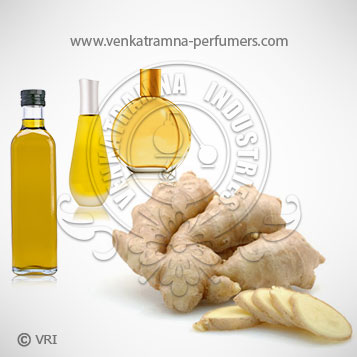
| Botanical Name | Zingiber Officinalis |
| Common Name | Jamaica Ginger |
| Country of Origin | China, Madagascar, Nigeria, West Indies, Jamaica, India, Japan |
| Solubility | Insoluble in water, soluble in alcohol and oils |
| Specific Gravity | 0.893 @ 72°F |
| Optical Rotation | -48.5 |
| Refrective Index | 1.4950 @ 72°F |
| PlantPart | Roots |
| Bland With | It can blend well with sandalwood, patchouli, rosewood, cedarwood, rose, coriander, frankincense, lime, orange, neroli, vetiver and bergamot. |
| CAS No | 8007-08-7 |
| Flash Point | 72°C |
| Extraction Method | Steam Distilled |
Ginger is a perennial herb that can stand up to about 3 - 4 feet high and has a thick spreading tuberous rhizome. The root of ginger is macerated and distilled over high heat, for extracting the oil. Ginger is widely used as spice, and it has its origins in India. It is a medicinal plant in folk and traditional medicines. The spice is very common in India (it is known as adrak in Hindi) and China and is now used all over the world. It forms an integral part of many Asian cuisines due to its digestive properties. It is especially helpful in digesting food items such as meat and poultry, and it is frequently added to recipes for cooking meat as it softens the meat considerably, making it easier to digest. Ginger root and ginger oil are also used as preservative and flavoring agents. The aim of this study was to review the chemical composition and biological activities of Z. officinale (ginger) essential oil. Ginger oil is extracted from Z. officinale rhizomes, which its chemical composition influences from geographical region, extraction methods, freshness or dryness of rhizomes. The antibacterial, antifungal, analgesic, anti-inflammatory, anti-ulcer, immunomodulatory, relaxant, and warming effects of ginger oil have been confirmed in experimental and preclinical studies.
The plant is said to originate from India, China and Java, but is also native to Africa and the West Indies. It is believed that ginger was brought to Europe between the 10th and 15th century as both a condiment and spice. It has been used for medicinal purposes since the ancient times; it is recorded specifically in both Sanskrit and Chinese texts. It is also mentioned in literature from the Greeks, Romans, and Arabians. Numerous studies have been carried out to characterize and isolate its main bioactive compounds to elucidate the mechanisms of its antimicrobial activity against pathogenic and spoilage microorganisms in foods. Results indicate that ginger contains monoterpenoids, sesquiterpenoids, phenolic compounds, and its derivatives, aldehydes, ketones, alcohols, esters, which provide a broad antimicrobial spectrum against different microorganisms and make it an interesting alternative to synthetic antimicrobials. However, its application in foods has been scarcely explored and represents an opportunity area for further research. This review provides an updated overview of the main bioactive compounds of ginger, its potential application, and toxicity as an antimicrobial in food products.
Color : Pale amber to greenish liquid @22C with Herbaceous odor,
Aroma : Ginger oil has a wary, spicy and woody scent.
This oil contains Zingiberene (40%), Ar-curcumene (20%). heptane, octane, isovaleraldehyde, nonanol, ethyl pinene, camphene, b-pinene, sabinene, myrcene, limonene, b-phellandrene and 1,8-cineole by GLC analysis
This essential oil is widely demanded by aroma therapists and is applicable for colds and flu, nausea (motion sickness, morning sickness), rheumatism, coughs and circulation issues. It has warming properties that helps in relieving muscular cramps, spasms, aches and ease stiffness in joints. The medicinal part of ginger is rhizomes, which are used in traditional medicine for treatment of wide range of ailments. In Ayurveda system, ginger and milk or water in the form of paste are used externally for treatment of infantile colic. The combination of ginger with honey is used for asthmatic bronchitis, cough, hiccups, and respiratory colds. Ginger is used for digestive problems in western medicine. Henry VIII recommended the use of ginger for preventing the plague. The prepared bread with ginger by Greeks is consumed after meal as digestive aid. Blood purifying, aphrodisiac, sex stimulants, appetizing, anti-flatulent, anti-spasmodic, anti-hemorrhoid, anti-vomiting, and anti-nausea effects of ginger are other traditional prospects. Ginger rhizomes are containing fatty oils (3-6%), proteins (9%), carbohydrates (60-70%), crude fiber (3-8%), ash (8%), water (9-12%), and volatile oil (2-3%). Nowadays, ginger hydro-ethanol extracts are extensively used as analgesic, anti-inflammatory, anticancer, anti-diabetic, hepato-protective, nephron-protective, and antioxidant agents